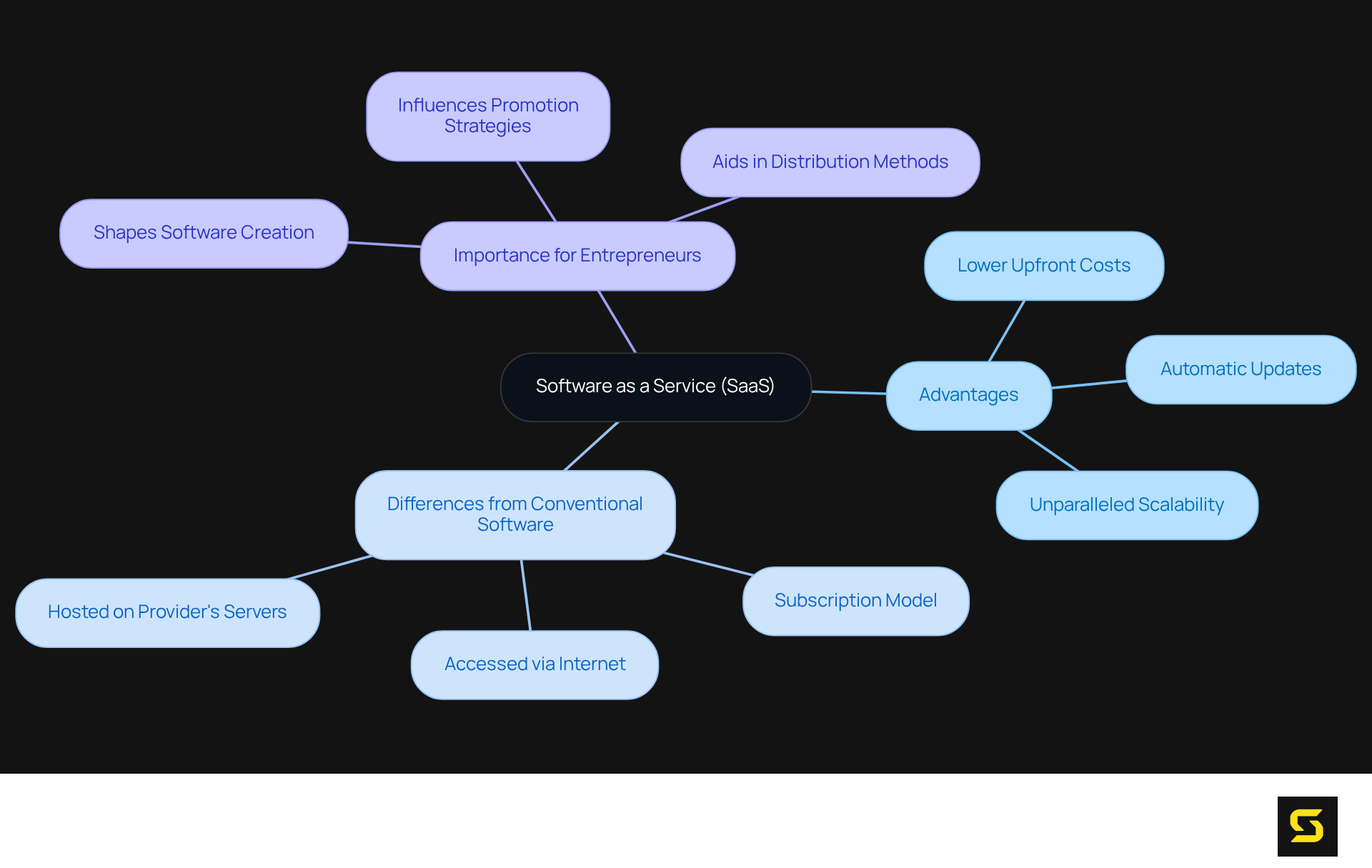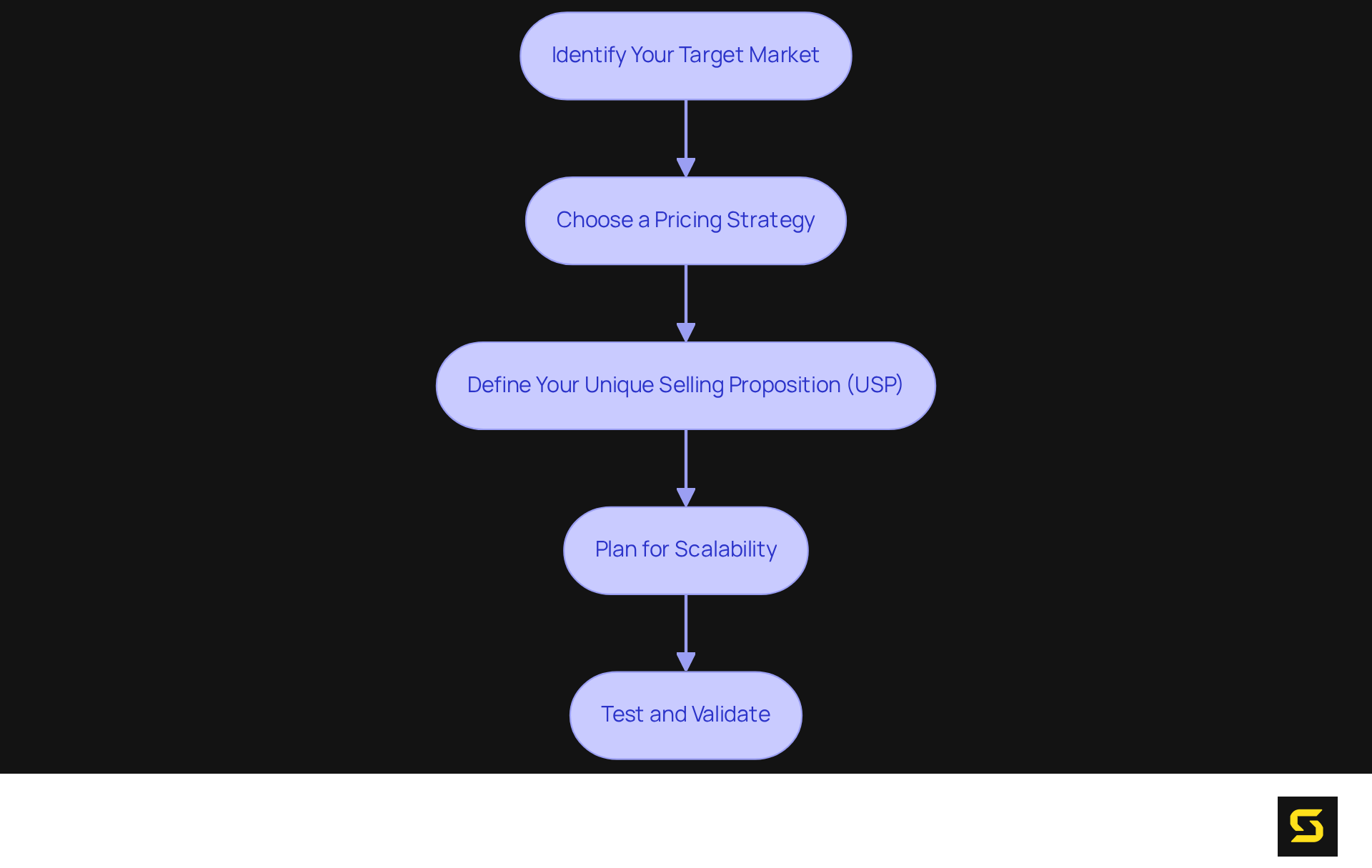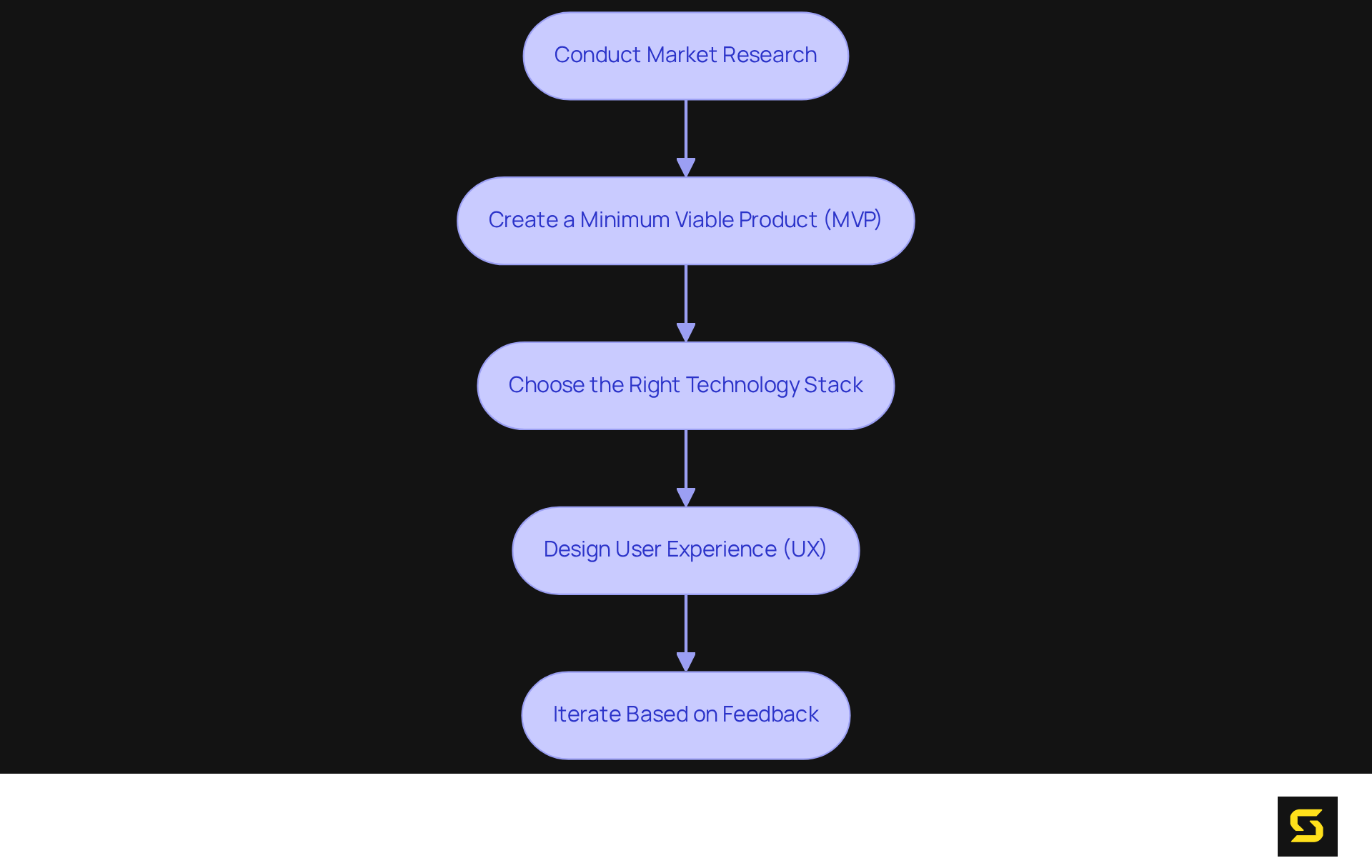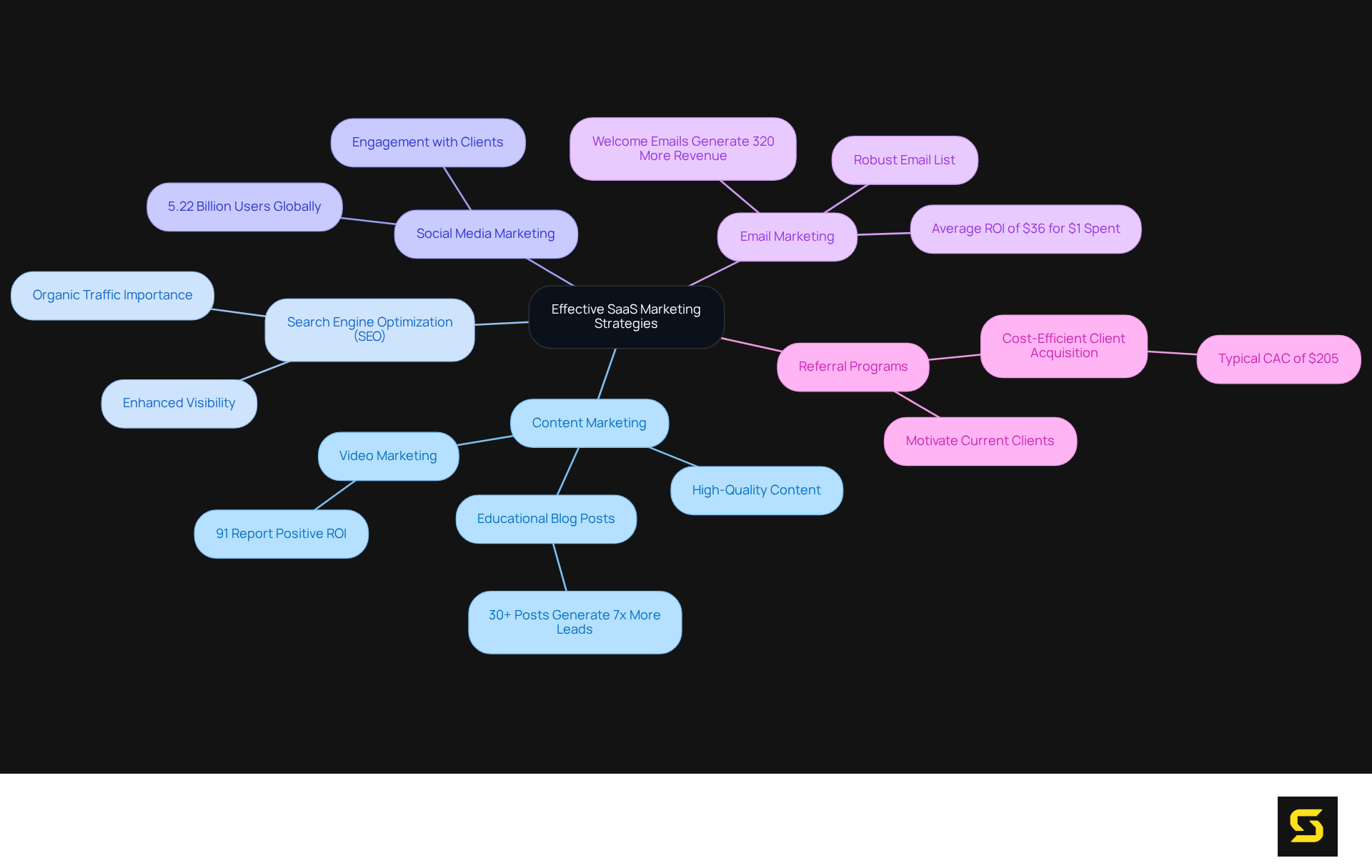Overview
The article delineates five essential steps for the successful launch of a Software as a Service (SaaS) startup. These steps encompass:
- Establishing a robust business model
- Developing a high-quality product
- Implementing effective marketing strategies
- Adapting the overall strategy based on performance evaluations
Each step is underpinned by comprehensive guidance on:
- Market research
- Pricing strategies
- User experience design
- Effective marketing techniques
This approach emphasizes the critical importance of understanding customer needs while maintaining agility in an increasingly competitive landscape. By following these steps, aspiring entrepreneurs can navigate the complexities of the SaaS market with confidence.
Introduction
Launching a Software as a Service (SaaS) startup presents a unique blend of excitement and challenges. In an ever-evolving digital landscape, the SaaS model empowers entrepreneurs to provide scalable solutions with reduced upfront costs and seamless updates. Yet, the journey to success is riddled with obstacles, from selecting the appropriate business model to crafting a product that aligns with customer needs. Aspiring founders must navigate this intricate landscape strategically, ensuring their SaaS startup not only endures but flourishes in a competitive market.
How will you rise to the challenge?
Define Software as a Service (SaaS)
Software as a Service (SaaS) represents a transformative approach to software distribution, where applications are hosted on the provider's servers and accessed via the internet. This model diverges significantly from conventional software, which requires local installation. Instead, SaaS empowers users to engage with applications through web browsers, typically through a subscription model.
The advantages of this approach are compelling:
- Lower upfront costs
- Automatic updates
- Unparalleled scalability
Understanding software as a service startup is not merely beneficial; it is essential for entrepreneurs, as it fundamentally shapes how they will create, promote, and distribute their software products. Embrace the SaaS model to position your business for success in a rapidly evolving digital landscape.

Establish Your SaaS Business Model
To establish your SaaS business model, follow these essential steps:
-
Identify Your Target Market: Understand your ideal clients and the specific issues your software addresses. This foundational step is crucial; building a product without knowing your audience often leads to failure. Utilize tools like buyer personas and audience segmentation to enhance your understanding of customer needs.
-
Choose a Pricing Strategy: Evaluate prevalent models such as subscription-based pricing, freemium models, and tiered pricing. Each model presents distinct advantages and disadvantages. Select one that aligns with your target audience's willingness to pay and the market expectations for 2025. Stay informed about current trends in pricing strategies to maintain competitiveness.
-
Define Your Unique Selling Proposition (USP): Articulate what differentiates your SaaS product from competitors. This may involve unique features, competitive pricing, or exceptional client support that resonates with your audience. Understanding customer profiles aids in crafting a compelling USP.
-
Plan for Scalability: Design your business model to accommodate growth. Consider how you will manage increased demand and the essential infrastructure necessary to support a growing clientele, ensuring your operations can scale effectively.
-
Test and Validate: Before fully committing to your business model, conduct tests with a small group of users. Gather input via surveys or focus groups to refine your strategy and implement necessary changes, ensuring your offering aligns with demand and expectations. Avoid assumptions about market needs without data, as this can lead to misalignment with customer expectations.

Develop Your SaaS Product
Developing your SaaS product entails several critical steps:
-
Conduct Market Research: Understanding consumer needs and preferences is paramount. Employ surveys, interviews, and competitor analysis to gather valuable insights. In 2025, effective market research is indispensable, as 75% of B2B buyers prefer to conduct independent research before engaging with a vendor. Moreover, with the average churn rate for software companies at 4.91% monthly, grasping customer preferences can significantly mitigate potential losses.
-
Create a Minimum Viable Product (MVP): Concentrate on constructing a fundamental version of your product that encompasses essential features. This strategy allows you to test your concept with real users without incurring substantial costs. Data indicates that companies adopting a product-led growth strategy experience 30% higher retention rates, emphasizing the necessity of a well-defined MVP.
-
Choose the Right Technology Stack: Opt for technologies that correspond with your product requirements and scalability objectives. Consider aspects such as performance, security, and ease of maintenance. The right technology can profoundly influence your product's success in a competitive market, especially as the average cost per click (CPC) for software advertising has surged to $4.66, thereby shaping marketing strategies.
-
Design User Experience (UX): Prioritize user-centric design to ensure your application is intuitive and easy to navigate. A robust UX can significantly enhance client satisfaction and retention, which is vital in an environment where the average churn rate for SaaS companies is 4.91% monthly.
-
Iterate Based on Feedback: After launching your MVP, gather feedback from users and implement iterative improvements to enhance functionality and experience. Incorporating customer testimonials can be particularly effective in addressing common objections and refining product development, as they provide social proof that fosters trust and credibility. Continuous adjustment informed by customer feedback is essential for maintaining relevance and competitiveness in a software as a service startup.

Implement Effective SaaS Marketing Strategies
To effectively market your SaaS product, consider implementing the following strategies:
-
Content Marketing: Develop high-quality content that addresses the specific pain points of your target audience. This can include blog posts, whitepapers, and case studies that not only establish your authority in the industry but also drive organic traffic. Research indicates that companies publishing over 30 educational blog posts each month generate seven times more leads than those that do not. Additionally, incorporating video marketing can significantly enhance user understanding and engagement, as 91% of businesses report positive ROI from video marketing.
-
Search Engine Optimization (SEO): Optimize your website and content for search engines to enhance visibility. A well-organized SEO approach can greatly enhance your opportunities for drawing organic traffic, which is essential for a software as a service startup looking to establish a strong clientele.
-
Social Media Marketing: Utilize social media platforms to engage with potential clients, share valuable content, and promote your product. With 5.22 billion people using social media globally, these platforms are essential for reaching and interacting with your audience effectively.
-
Email Marketing: Build a robust email list and implement targeted campaigns to nurture leads. Efficient email marketing can yield an average ROI of $36 for every $1 invested, making it an essential tool for keeping current clients informed about updates and promotions. Significantly, welcome emails produce 320% more revenue than other promotional messages, emphasizing their effectiveness in engaging clients.
-
Referral Programs: Motivate current participants to recommend new clients by providing rewards. This strategy not only aids in growing your user base naturally but also utilizes the trust and satisfaction of your existing clients, which is essential in a competitive market. Considering that the typical Client Acquisition Cost (CAC) for B2B software services is $205, referral programs can be a cost-efficient method to expand your client base.
By concentrating on these strategies, a software as a service startup can enhance its marketing initiatives, improve client acquisition, and ultimately drive growth. Furthermore, with 75% of B2B buyers preferring to research independently before contacting a vendor, content marketing plays a pivotal role in facilitating this self-service research.

Evaluate and Adapt Your SaaS Strategy
To effectively evaluate and adapt your SaaS strategy, consider the following essential steps:
-
Track Key Performance Indicators (KPIs): Regularly monitor essential metrics such as customer acquisition cost (CAC), churn rate, and monthly recurring revenue (MRR). Understanding the average CAC for SaaS companies in 2025 is crucial for gauging the efficiency of your marketing efforts. Strive for a CLV:CAC ratio of approximately 3:1 to ensure sustainable growth.
-
Gather Participant Feedback: Actively seek input from users through methods such as surveys, interviews, and usability tests. This practice not only aids in identifying areas for enhancement but also fosters loyalty by making users feel valued. Implementing a structured feedback loop can significantly elevate product development.
-
Analyze Market Trends: Remain vigilant about industry trends and competitor activities. Grasping changes in the market will guide your strategic decisions and help maintain your competitive edge. Utilize tools that monitor industry dynamics and customer engagement scores to assess your standing.
-
Conduct Regular Reviews: Schedule periodic assessments of your business strategy. These evaluations should focus on what is functioning effectively and what requires modification, ensuring that your strategy remains aligned with your objectives and industry conditions.
-
Be Agile: Foster a culture of agility within your organization. Be prepared to pivot your strategy based on data insights and user feedback. Flexibility is a vital advantage for a software as a service startup in the rapidly evolving SaaS landscape, allowing it to respond effectively to changing customer needs and market demands.
![]()
Conclusion
Launching a Software as a Service (SaaS) startup demands a strategic approach that encompasses a profound understanding of the SaaS model, the definition of a robust business framework, the development of a compelling product, the implementation of effective marketing strategies, and the continuous evaluation and adaptation of growth strategies. By embracing this innovative distribution method, entrepreneurs position themselves to thrive in a competitive digital landscape.
Key steps include:
- Identifying the target market
- Selecting a suitable pricing strategy
- Crafting a unique selling proposition that distinguishes the product from competitors
Moreover, developing a minimum viable product (MVP) and prioritizing user experience are essential for ensuring customer satisfaction and retention. Effective marketing strategies, such as content marketing and social media engagement, play a vital role in attracting and retaining clients, while ongoing evaluation of performance metrics refines business strategies.
Ultimately, the journey to a successful SaaS startup is characterized by adaptability and a steadfast commitment to understanding customer needs. Entrepreneurs are urged to leverage the insights and strategies discussed to navigate the complexities of the SaaS landscape. By prioritizing customer feedback and remaining agile in response to market trends, startups can foster sustainable growth and establish a formidable foothold in the ever-evolving world of software as a service.
Frequently Asked Questions
What is Software as a Service (SaaS)?
Software as a Service (SaaS) is a software distribution model where applications are hosted on the provider's servers and accessed via the internet, typically through a web browser. It differs from traditional software that requires local installation and often operates on a subscription model.
What are the advantages of using SaaS?
The advantages of SaaS include lower upfront costs, automatic updates, and unparalleled scalability.
Why is understanding SaaS important for entrepreneurs?
Understanding SaaS is essential for entrepreneurs as it shapes how they create, promote, and distribute their software products, positioning their business for success in a rapidly evolving digital landscape.
What are the essential steps to establish a SaaS business model?
The essential steps include identifying your target market, choosing a pricing strategy, defining your unique selling proposition (USP), planning for scalability, and testing and validating your model with users.
How can I identify my target market for a SaaS product?
You can identify your target market by understanding your ideal clients and the specific issues your software addresses, utilizing tools like buyer personas and audience segmentation.
What pricing strategies can I consider for my SaaS business?
You can consider subscription-based pricing, freemium models, and tiered pricing, each with its own advantages and disadvantages. Select a strategy that aligns with your target audience's willingness to pay and market expectations.
What is a Unique Selling Proposition (USP) in the context of SaaS?
A Unique Selling Proposition (USP) articulates what differentiates your SaaS product from competitors, which may include unique features, competitive pricing, or exceptional client support that resonates with your audience.
How should I plan for scalability in my SaaS business model?
You should design your business model to accommodate growth by considering how to manage increased demand and the necessary infrastructure to support a growing clientele.
Why is testing and validating my SaaS business model important?
Testing and validating your business model with a small group of users helps gather input to refine your strategy and ensure your offering aligns with market demand and customer expectations, avoiding assumptions that could lead to misalignment.





